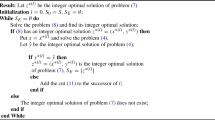Abstract
This work shows how disjunctive cuts can be generated for a bilevel linear programming problem (BLP) with continuous variables. First, a brief summary on disjunctive programming and bilevel programming is presented. Then duality theory is used to reformulate BLP as a disjunctive program and, from there, disjunctive programming results are applied to derive valid cuts. These cuts tighten the domain of the linear relaxation of BLP. An example is given to illustrate this idea, and a discussion follows on how these cuts may be incorporated in an algorithm for solving BLP.
Similar content being viewed by others
References
Audet C. Optimisation globale structurée: Propriétés, équivalences et résolution. Ph.D. thesis (1997)
Audet C., Hansen P., Jaumard B., Savard G. (1997) Links between linear bilevel and mixed 0–1 programming problems. J. Optim. Theory Appl. 93(2): 273–300
Audet C., Hansen P., Jaumard B., Savard G. (1999) A symmetrical linear maxmin approach to disjoint bilinear programming. Math. Program. 85(3, Ser. A): 573–592
Audet, C., Savard, G., Zghal, W. New branch-and-cut algorithm for bilevel linear programming. J. Optim. Theory Appl. (2004) (in press)
Balas E. (1985) Disjunctive programming and a hierarchy of relaxations for discrete optimization problems.SIAM J. Disc. Meth. 6(3): 466–486
Balas, E., Perregaard, M. Lift-and-project for mixed 0–1 programming: Recent progress. Technical report, Carnegie Mellon University (1999)
Balas E., Ceria S., Cornuéjols G. (1993) A lift-and-project cutting plane algorithm for mixed 0–1 programs. Math. Program. 58, 295–324
Bard J.F., Plummer J., Sourie J.-C. (2000). A bilevel programming approach to determining tax credits for biofuel production. Eur. J. Oper. Res. 120, 30–46
Bernstein D.H., Chen M. (2004) Solving the toll design problem with multiple user groups. Transpor. Res. B 38, 61–79
Bonami, P. Étude et mise en oeuvre d’approches polyédriques pour la résolution de programmes en nombres entiers ou mixtes généraux. Ph.D. thesis (2003)
Dempe, S. Discrete bilevel optimization problems. Technical Report 12, Universitat Leipzig, Wirtschaftswissenschaftliche Fakultat, Institut fur Wirtschaftsinformatik, citeseer.ist.psu.edu/dempe01discrete.html (1996)
Deng X. (1997). Complexity issues in bilevel linear programming. In: Migdalas A., Pardalos P.M., Varbrand P. (eds). Multilevel optimization: algorithms and applications. Kluwer, Dordrecht, pp. 149–164
Fliege, J., Vicente, L.N. A multicriteria approach to bilevel optimization. Preprint 03–08, Department of Mathematics, University of Coimbra, Portugal, http://www.optimization-online.org/DB_HTML/2003/05/649.html (2003)
Fortuny-Amat J., McCarl B. (1981) A representation and economic interpretation of a two-level programming problem. J. Oper. Res. Soc. 32, 783–792
Hansen P., Jaumard B., Savard G. (1992) New branch and bound rules for linear bilevel programming. SIAM J. Sci. Stat. Comput. 13, 1194–1217
Hejazi S.R., Jahanshahloo G., Memariani A., Sepehri M.M. (2002) Linear bilevel programming solution by genetic algorithm. Comput. Opera. Res. 29, 1913–1925
Júdice J., Savard G., Vicente L. (1994) Descent approaches for quadratic bilevel programming. J. Optim. Theory Appl. 2(81): 379–399
Loridan P., Morgan J. (1989) A theoretical approximation scheme for Stackelberg problems. J. Optim. Theory Appl. 61, 95–110
Migdalas A., Pardalos P.M. (eds.). Special issue on Hierarchical and Bilevel Programming. J. Global Optim. 8(3) (1996)
Savard, G. Contribution à la programmation mathématique à deux niveaux. Ph.D. thesis (1989)
Author information
Authors and Affiliations
Corresponding author
Rights and permissions
About this article
Cite this article
Audet, C., Haddad, J. & Savard, G. Disjunctive cuts for continuous linear bilevel programming. Optimization Letters 1, 259–267 (2007). https://doi.org/10.1007/s11590-006-0024-3
Accepted:
Published:
Issue Date:
DOI: https://doi.org/10.1007/s11590-006-0024-3




